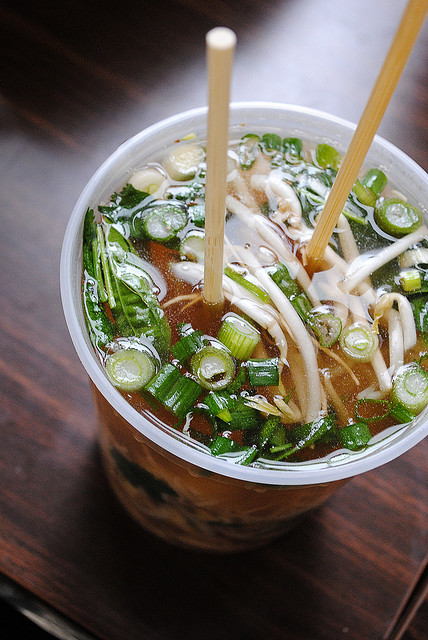Seasonal Allergies Affecting the Workplace? Here Are 6 Ways to Plan Health-Boosting Office Meals
Watery eyes, sneezing, scratchy throat — ah, it must be spring. Along with beautiful blossoms and rising temperatures comes the yearly onset of seasonal allergies, commonly called hay fever, which affect nearly 18 million American adults each year. But before you head to the drugstore or resign yourself to weeks of misery, take a second look at what you’re eating each day. Your diet can have a big impact on how your seasonal allergy symptoms show up, for better or for worse.

Image source: Flickr user Lis Ferla
And while it’s easy to plan ahead for the dinners and weekends you cook at home, your office meals can be a little trickier… so here are six ways to ensure allergy-alleviating dining in the workplace.

Image source: Flickr user Bastian Eichhorn
1) Takeout time? Vote for sushi, and stick to salmon and tuna rolls. Some studies have shown that omega-3 fatty acids may help alleviate allergy symptoms, and fatty fish are the best sources of omega-3s.
2) Trade your morning latte for a mug of hot tea. Black tea is rich in the flavonoid quercetin, which has natural anti-inflammatory properties that can decrease your body’s production of histamine (thus relieving symptoms of allergic reactions).

Image source: Flickr user Celeste Lindell
3) Kiwis, strawberries, papaya, mangoes: all these fruits pack more vitamin C than the iconic orange, which means they may also function as natural anti-histamines. Plus, they’re frequent guests at many catered office breakfasts. Skip the sugary doughnuts or bagels, and load your plate with fruit for an allergy-fighting start to the day.
4) But, if you suffer from a ragweed allergy, beware of certain raw fruits and vegetables at any meal. Bananas, melon, zucchini, and sunflower seeds all contain proteins that the body can mistake for ragweed pollen, which means eating them can trigger a case of “mistaken identity” allergic reaction resulting in a scratchy throat. This phenomenon is called oral allergy syndrome, and simply paying attention to your body’s responses can help you determine if you’re susceptible. Similar reactions can occur in people with birch pollen allergies when they eat apples, almonds, pears, and cherries; similarly, those allergic to grass pollen may experience allergy-like symptoms when they consume tomatoes and celery. The good news is that once the foods are cooked, no issues arise, because the lookalike proteins are distorted by heat… so if you’re affected, say yes to spaghetti with marinara, but no to a Caprese salad.

Image source: Flickr user Matt DeTurck
5) If you’re ordering takeout from a Japanese place, start your meal with miso soup. The deli? Chicken noodle. In the mood for Thai food? Tom kha gai. Basically, any hot, clear soup can help relieve congestion, and nearly every cuisine includes an option to add to your lunch order.
6) We know that nuts are the ideal office snack thanks to their high protein content and disease-prevention powers, and they can also help fight allergy symptoms — especially walnuts. Like fish, they contain omega-3 fatty acids, along with immunity-boosting vitamin E and magnesium. Skip the chips for your afternoon snack and have a handful of nuts instead.
Allergies can be real drag each spring, but Waiter.com is on your side. With convenient online ordering and prompt delivery, we make eating a healthy office meals easier — and hopefully help you breathe easier, too.